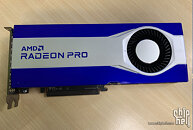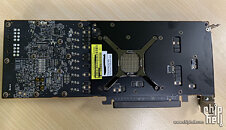Thursday, April 8th 2021

AMD Radeon Pro Workstation Card with Navi 21 GPU Pictured
When AMD introduced RDNA 2 architecture and higher-end Navi 21 GPU SKUs, it was only a matter of time before the company launches these GPUs inside professional-grade graphics cards. Today, thanks to the Chiphell forums, we have pictures and some specifications of AMD's upcoming Radeon Pro workstation graphics card. Pictured below is a new RDNA 2 based design that features AMD's Navi 21 GLXL GPU SKU. The new GLXL GPU SKU is supposed to be rather similar to the Navi 21 XL GPU found inside AMD's Radeon RX 6800 XT graphics card, judging by the number and arrangement of capacitors on the back of the card.
When it comes to memory, the upcoming Radeon Pro workstation card is featuring 16 GB of VRAM, likely a variant of GDDR6 found on gaming-oriented graphics cards from RDNA 2 generation. When it comes to cooler design, the Radeon Pro graphics card has a blower-type cooler helping tame the Navi 21 GLXL GPU. Given that blower-type coolers are suitable for situations with less airflow, the TDP of this card could be around or under 250 Watts. You can take a look at the card below, however, do note that it is an engineering sample and the final product can look a bit different.
Sources:
Chiphell, via VideoCardz
When it comes to memory, the upcoming Radeon Pro workstation card is featuring 16 GB of VRAM, likely a variant of GDDR6 found on gaming-oriented graphics cards from RDNA 2 generation. When it comes to cooler design, the Radeon Pro graphics card has a blower-type cooler helping tame the Navi 21 GLXL GPU. Given that blower-type coolers are suitable for situations with less airflow, the TDP of this card could be around or under 250 Watts. You can take a look at the card below, however, do note that it is an engineering sample and the final product can look a bit different.


13 Comments on AMD Radeon Pro Workstation Card with Navi 21 GPU Pictured
EDIT;
@Caring1
Looks like he corrected it.
- Yes.
CDNA is for supercomputers, a totally different subject matter. Personally speaking, I think the CDNA thing is more about AMD just not having the resources to reasonably port ROCm over to RDNA / 32-sized wavefronts. RDNA's architecture is very well designed and clearly superior to Vega / CDNA in many regards. All CDNA has going for it is "Deep Learning" instructions and ROCm.
My university gives mechanical engineering students like me Solidworks, each year. And, until the 2019 version, it ran with OpenGL 2.0 (2004). With my Vega 64, which I know has the worst support for old OpenGL, with any reasonably complex assembly with lots of transparencies it was slow as ****, 1.5-2fps when modeling. Heck, the 1050 mobile in my XPS15 laptop ran at ~40-45fps the same model.
Thankfully, Solidworks 2020 switched to OpenGL 4.5 (2014, not for gaming cards, but there are hacks for enabling it, and I did that). Results? I had at least 50 times more FPS with the same model (at least 75-100fps). Zero enhancements on the laptop, though.
Solidworks competitors are much better optimized for modern PCs, BTW. Autodesk Inventor uses DirectX 11 since 2011, and Siemens NX uses OpenGL 4.x since 2013-14. Neither of those is as user-friendly as Solidworks IMHO, having used all 3.